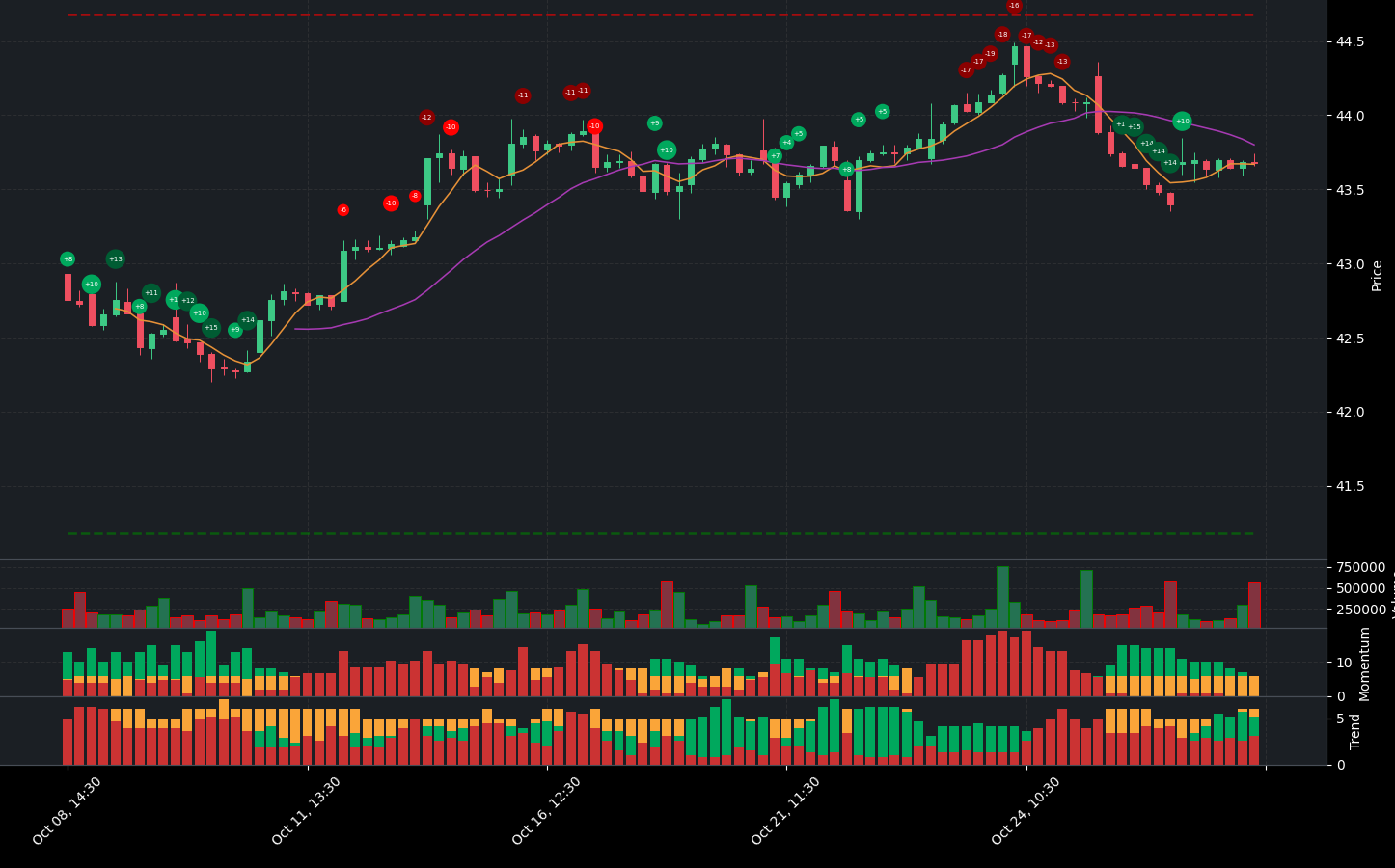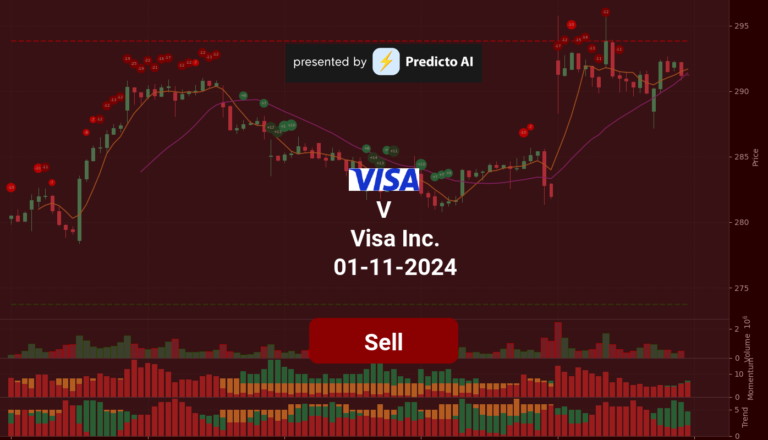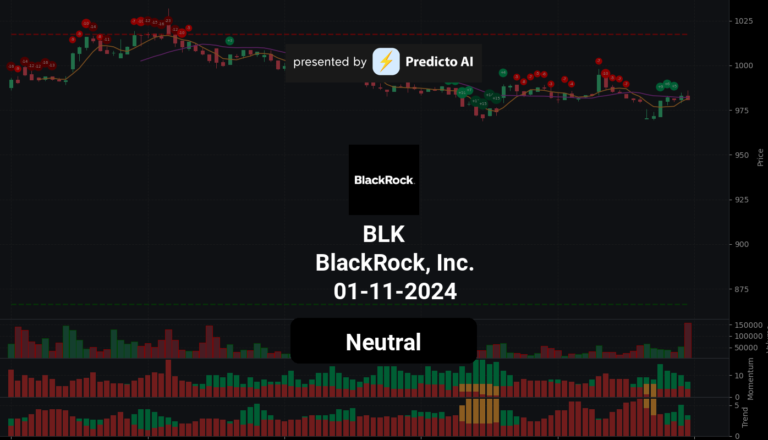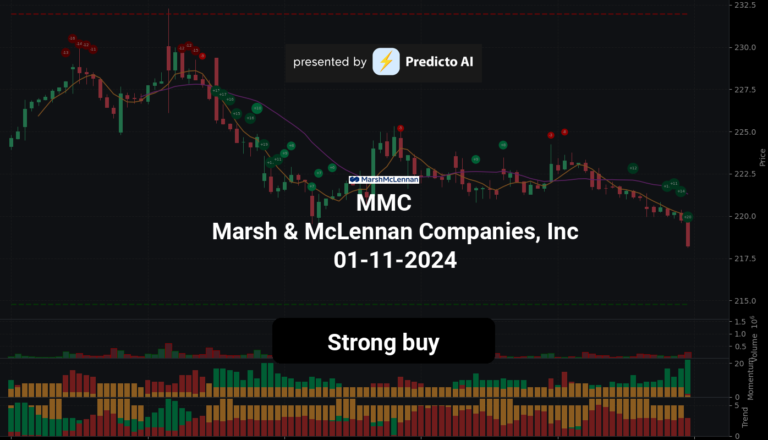FE Stock Analysis: A Mixed Bag of Opportunities and Risks
🔴 Recommendation: FirstEnergy Corp. (FE) presents a complex investment landscape, with a cautious approach advised due to conflicting signals in both technical indicators and financial health.
📈 Key Highlights:
Price Action: Currently experiencing neutral price action, with some bullish signs as it trades above the 200-day EMA.
Momentum Indicators: The WaveTrend indicator suggests the stock is oversold, hinting at a potential rebound opportunity.
Institutional Ownership: Strong backing from institutional investors, with ownership at 85%, indicating a stable investment environment.
⚠️ Caution Flags:
Financial Health: Concerning financial metrics, including a high Debt-to-Equity Ratio of 4.32 and a low Current Ratio of 0.36, raise red flags about liquidity and financial leverage.
Negative Earnings Growth: A staggering -80.90% in earnings growth signals potential challenges ahead for profitability.
Upcoming Earnings Report: The impending Q3 earnings release could introduce volatility, making it crucial for investors to stay alert.
As we delve deeper into the analysis, we will explore the price trends, technical indicators, financial health, valuation metrics, and more to provide a comprehensive overview of FE’s current standing and future outlook. Stay tuned for the detailed breakdown below! 👇
FE Price Analysis

| Positive Momentum Signals | Negative Momentum Signals | Hold Momentum Signals |
|---|---|---|
|
|
| Positive Trend Signals | Negative Trend Signals | Hold Trend Signals |
|---|---|---|
|
|
|
FE stock presents a complex picture for investors, characterized by both potential opportunities and significant risks. Currently, the stock is experiencing a neutral price action, indicating a lack of strong directional movement. However, there are some positive momentum indicators to consider. The WaveTrend indicator suggests that the stock is oversold, which could signal a potential bottom and an opportunity for a rebound.
On the trend front, FE is showing some bullish signs. The price is currently above the 200-day EMA, indicating a bullish trend that appears to be strengthening. Additionally, the MACD has shown a positive histogram crossover, which is often interpreted as a bullish signal. These indicators suggest that there may be some upward momentum in the near term.
However, caution is warranted due to several negative trend indicators. The stock is below the Middle Band and above the Lower Band, which indicates a downtrend, albeit one that may be tempered by oversold conditions. The On-Balance Volume (OBV) is decreasing, suggesting that the buying pressure is waning, and the high volume is also decreasing, which could indicate a lack of conviction among buyers. Furthermore, the price is below the 50-day EMA, reinforcing a bearish trend that is strengthening, and the Supertrend indicator is also bearish, indicating that the price is below the Supertrend line.
In summary, while FE stock has some positive momentum and trend indicators that suggest potential for a rebound, the overall picture remains mixed. The bearish signals from the 50-day EMA and Supertrend, combined with decreasing volume and OBV, indicate that investors should approach with caution. A hold or cautious buy recommendation may be prudent, as the stock navigates through these conflicting signals. Investors should keep a close eye on upcoming price movements and volume trends to better assess the stock’s trajectory.
FE Fundamental Analysis
FE’s recent financial performance raises significant concerns for investors. The company reported a net income of $45 million for the most recent period; however, the year-over-year trend shows a troubling decrease, which casts doubt on future profitability.
The financial health of FE is alarming, highlighted by an extremely high debt-to-equity ratio of 4.32, indicating substantial financial leverage and increased risk. Additionally, the current ratio of 0.36 suggests potential liquidity issues, raising questions about the company’s ability to meet short-term obligations. The cash to total assets ratio of only 0.01 further underscores limited financial flexibility and vulnerability to economic downturns.
In terms of valuation, FE appears to be overvalued with a forward P/E ratio of 15.11, especially in light of a negative earnings growth rate of -80.90%. The price-to-sales ratio of 1.97 indicates that the stock may be priced high relative to its sales, which could deter potential investors.
Growth and profitability metrics are equally concerning. The company has experienced a negative revenue growth of -0.21%, signaling a decline in sales that could adversely affect stock performance. Although the operating margin is high at 97.44%, the net profit margin is disappointingly low at 1.37%, raising doubts about the company’s efficiency in converting revenue into profit. The significant negative earnings growth further exacerbates concerns regarding future profitability and growth potential.
Shareholder information reveals additional risks, with an average of 574,590,297 ordinary shares outstanding, which could lead to dilution if the company opts to issue more shares. High levels of share-based compensation may also dilute earnings, negatively impacting shareholder value.
The income statement reflects troubling trends, with total revenue of $3.28 billion accompanied by a year-over-year revenue decline of -0.21%. The company is facing a negative net interest income of -$256 million, indicating that it is paying more in interest than it is earning, which could further strain profitability. The effective tax rate of 39.90% aligns with standard corporate rates, but the overall financial performance remains concerning.
On the balance sheet, the average net debt stands at $24.09 billion, warranting scrutiny regarding its impact on financial flexibility. The high debt-to-equity ratio and low current ratio raise significant concerns about the company’s financial risk profile.
Cash flow analysis reveals a negative free cash flow of -$2.05 billion, raising alarms about the company’s ability to fund operations and pursue growth opportunities. Although average capital expenditures of $2.63 billion suggest investment in growth, the negative cash flow could severely limit this potential.
Overall, FE’s financial health is troubling, characterized by high debt levels, negative earnings growth, and liquidity risks. These factors culminate in a strong sell recommendation. Investors should approach with caution and carefully assess the company’s ability to navigate its financial challenges before considering any investment.
Financial Health
🔴 Net Income for the most recent period was $45 million, but the year-over-year net income trend shows a decrease, raising concerns about future profitability.
🔴 The Debt-to-Equity Ratio is extremely high at 4.32, indicating significant financial leverage and potential risk.
🔴 Current Ratio is low at 0.36, suggesting potential liquidity risk and challenges in meeting short-term obligations.
🔴 Cash to Total Assets Ratio is only 0.01, indicating limited financial flexibility and vulnerability to economic shocks.
Valuation
🔴 Forward P/E ratio of 15.11 may suggest the stock is overvalued given the negative earnings growth of -80.90%.
🔴 Price-to-Sales Ratio of 1.97 indicates that the stock may be priced high relative to its sales, which could be a concern for investors.
Growth and Profitability
🔴 Revenue Growth (YoY) is negative at -0.21%, indicating a decline in revenue, which could negatively impact the stock price.
🔴 Operating Margin is high at 97.44%, but the Net Profit Margin is low at 1.37%, raising concerns about the company’s ability to convert revenue into actual profit.
🔴 Negative earnings growth of -80.90% raises significant concerns about future profitability and growth potential.
Shareholder Information
🔴 Average Ordinary Shares Outstanding is 574,590,297, which could indicate dilution risk if the company issues more shares.
🔴 High levels of share-based compensation may dilute earnings further, impacting shareholder value.
Income Statement
🔴 Total Revenue for the most recent period was $3.28 billion, but the year-over-year revenue growth of -0.21% indicates a concerning trend.
🔴 Net Interest Income is negative at -$256 million, suggesting the company is paying more in interest than it is earning, which could impact profitability.
🔴 Effective Tax Rate of 39.90% is in line with the standard corporate tax rate, but the overall financial performance is still concerning.
Balance Sheet
🔴 Average Net Debt is high at $24.09 billion, which warrants further investigation into its impact on financial flexibility.
🔴 The high Debt-to-Equity Ratio of 4.32 raises significant concerns about the company’s financial risk profile.
🔴 Current Ratio of 0.36 indicates potential difficulties in meeting short-term obligations.
Cashflow
🔴 Free Cash Flow is negative at -$2.05 billion, raising concerns about the company’s ability to fund operations and invest in growth.
🔴 Average Capital Expenditures of $2.63 billion suggest investment in growth, but the negative cash flow could limit this potential.
Overall, the company’s financial health is concerning, with high debt levels, negative earnings growth, and liquidity risks. The combination of these factors leads to a strong sell recommendation.
FE News Analysis
FirstEnergy Corp. (FE) is experiencing a mix of developments that could influence investor sentiment. The high institutional ownership suggests stability, while recent infrastructure improvements may enhance operational efficiency. However, upcoming earnings reports could introduce volatility.
Summary of FE news indicates a blend of stability and potential growth opportunities. The institutional ownership is a positive sign, but the upcoming earnings release could lead to fluctuations in stock performance. Investors should weigh these factors carefully.
🟢 FirstEnergy Corp. (NYSE:FE) is heavily dominated by institutional owners, with **85% ownership** of the shares.
🟢 This high level of institutional ownership typically indicates a **stable investment** environment, as institutional investors often conduct thorough research before investing.
🔴 A new transformer has been installed and energized in the Downtown Bradford Substation, which may improve service reliability but does not directly impact stock performance.
🟢 FirstEnergy is set to release its Q3 earnings soon, which could provide insights into the company’s financial health and operational efficiency.
🔴 The earnings report could lead to **increased volatility** in the stock price, depending on the results and market expectations.
🟢 New remote-controlled equipment is being introduced to prevent or shorten power disruptions in Western Pennsylvania, indicating a commitment to improving service quality.
🔴 Comparatively, other energy companies like DTE Energy and NextEra Energy have recently reported strong earnings, which may put pressure on FE to perform well in its upcoming report.
FE Holders Analysis
The financial health of FE shows a mixed outlook, with strong institutional backing but low insider ownership raising some concerns.
🟢 FE has a very high institutional ownership at **94.01%**, indicating significant interest from large investors, which can provide stability and confidence in the stock’s performance.
🔴 However, the **0.12% insider ownership** is notably low, suggesting a lack of confidence from company management or a high degree of external control, which could be a red flag for potential investors.
🟡 The number of institutional holders is substantial at **995**, indicating a diversified ownership structure, which can mitigate risks associated with individual investors selling off their shares.
🟡 Recent insider transactions show a pattern of selling, but there have been no significant insider purchases in the last six months, which may indicate a lack of confidence in the stock’s near-term performance.
🔴 The volatility associated with high institutional ownership could lead to significant price fluctuations if major holders decide to sell, which is a risk to consider.
FE Analyst Ratings
The analyst ratings for FE show a mixed sentiment, with a total of 1 strong buy, 5 buy, 11 hold, and no sell or strong sell recommendations in the most recent month. This indicates a cautious outlook among analysts. The recent upgrades from Keybanc to Overweight and the neutral stance from JP Morgan suggest that while there is some optimism, it is tempered by uncertainty.
🟡 Over the past month, the distribution of ratings indicates a lack of strong bullish or bearish sentiment, with 1 strong buy, 2 buy, 6 hold, 1 sell, and no strong sell ratings. This reflects a balanced view, leaning slightly towards caution.
🟢 Given the current analyst ratings and the lack of significant upgrades or downgrades, it is likely that the stock will remain stable over the next month. However, the medium confidence level suggests that investors should be prepared for potential fluctuations in response to market conditions or company-specific news.
FE Economic Analysis
Based on the US economic and market data:
🔴 The unemployment rate has increased to 4.3%, up from 4.1% in the previous month, indicating a potential slowdown in the labor market which could negatively impact consumer spending and, consequently, FirstEnergy’s revenue growth.
🟡 Retail sales have shown a slight increase, but the overall growth is modest, suggesting that consumer demand is not robust enough to drive significant revenue increases for utilities like FirstEnergy.
🟢 The GDP growth rate remains stable, which is generally positive for the economy, but the recent trends in unemployment and retail sales could offset this stability.
🔴 The increase in the CPI indicates rising inflation, which could lead to higher operational costs for FirstEnergy, impacting profit margins.
🟡 The overall market indices are currently showing mixed signals, with no clear upward or downward trends, suggesting uncertainty in the market environment.
In summary, while there are some positive indicators, the negative trends in unemployment and inflation could weigh on FirstEnergy’s stock performance in the coming month. The price is likely to remain within the range of $42.6 to $47.5, with a potential target mean price of $47.1.
Disclaimer
Investors may consider the AI predictions and news summaries as one factor in their investment decisions alongside their own research and risk tolerance.




